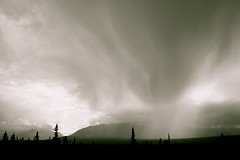 Sometimes a photo just looks better in black and white. You know, from time to time you’ll be digitally rifling through a folder of photographs and there’ll be one or two that just don’t suit being in glorious technicolour. So what to do? Well here are a few tips:
Sometimes a photo just looks better in black and white. You know, from time to time you’ll be digitally rifling through a folder of photographs and there’ll be one or two that just don’t suit being in glorious technicolour. So what to do? Well here are a few tips:
1. Don’t write the photo off just because it doesn’t work in colour. It may look fantastic in black and white.
2. Don’t just convert to greyscale or desaturate. This will most likely look boring and low contrast. Most programs (including free ones like Picasa) have some kind of “filtered black and white” option (in Photoshop this is the channel mixers). This allows you to select a colour filter (some programs will have more choices than others) which will let you keep much more of the detail in your photo. Play around with the different filters and see which ones work best for your photo.
3. Play with the photo in colour first. Before you convert to black and white do any corrections e.g. red eye removal, exposure, contrast etc. while the photos still in colour.
4. Play more once it’s black and white! Don’t be afraid to make more corrections once you’ve converted it.You can always undo anything you regret!
5. Don’t be afraid to try Auto Levels or Auto Contrast. If you don’t like what they do you can always undo it and you may find it gives you the perfect photo without you having to mess around with levels or contrast yourself – that’s not cheating so don’t make work for yourself!
If you want to go and shoot with black and white images in mind try these tips:
1. Shoot in colour! If you’re shooting JPEGs shoot in colour, you’ll have much more control over your image later than if you shoot in black and white mode. If you’re shooting in RAW you can shoot in black and white mode because your camera will record all the information anyway.
2. Use a low ISO, as low as possible. Noise is more obvious in black and white photos and using the lowest ISO will help avoid very grainy photos.
3. Pay attention to light. Light is very important in black and white photos because, obviously, you’ve got no colour. Try and look for light that will add texture and contrast to your image. Light coming from one direction is good for this because it will give shadows.
4. Practice! Like anything photography takes practice to improve. Set a challenge for yourself to produce a certain number of black and white photos over the next month, or decide to convert at least one photo from each shoot you do into black and white (you can always keep the colour shot too). Practice, practice, practice, and you’ll get better even if you don’t get perfect!
If you’ve got tips of your own for digital black and white photography let us know in the comments.









About Tip #2: I find in some photos that the noise may be less obvious, depending on your settings in the channel mixer. That’s always one of the things I check for when deciding how to do a b&w conversion. Pretty sure the last one I did had noticeably less noise in the red channel, but I suppose it may vary from photo to photo (and camera to camera).